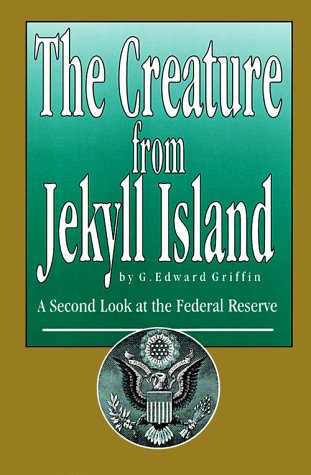
“The Creature from Jekyll Island: A Second Look at the Federal Reserve” is a controversial and thought-provoking book written by G. Edward Griffin. Published in 1994, it delves into the origins and operations of the Federal Reserve System, offering a critical analysis from a conspiracy theory perspective.
Griffin presents the Federal Reserve as a secretive and powerful entity, suggesting that it operates to serve the interests of a select few rather than the public good. He argues that the Federal Reserve’s creation was orchestrated by powerful banking and political figures during a clandestine meeting on Jekyll Island in 1910, and since its establishment in 1913, it has wielded disproportionate influence over the economy.
The book explores various historical events and economic theories to support its claims, drawing attention to instances of financial manipulation, inflation, and government debt. Griffin contends that the Federal Reserve’s control over monetary policy allows it to perpetuate cycles of boom and bust, enriching the financial elite while impoverishing the masses.
While “The Creature from Jekyll Island” has garnered a following among conspiracy theorists and critics of central banking, it has also faced significant scrutiny from economists and historians. Critics argue that Griffin’s narrative oversimplifies complex economic processes and ignores the Federal Reserve’s role in stabilizing the economy and preventing financial crises.
Let’s look into the key aspects of “The Creature from Jekyll Island.”
- Historical Context: The book begins by setting the stage with the historical context surrounding the creation of the Federal Reserve. Griffin outlines the economic and political climate of the early 20th century, emphasizing the concerns about banking monopolies and financial instability. He highlights the secretive meeting on Jekyll Island in 1910, where influential figures such as bankers, politicians, and economists devised the blueprint for what would become the Federal Reserve System.
- The Federal Reserve’s Origins: Griffin asserts that the Federal Reserve Act of 1913, which established the Federal Reserve System, was passed under dubious circumstances. He argues that the legislation was pushed through Congress with the support of powerful banking interests, including figures such as J.P. Morgan and Paul Warburg, who stood to benefit from centralized control over the nation’s money supply.
- Central Banking and Monetary Policy: The book delves into the mechanics of central banking and monetary policy, critiquing the Federal Reserve’s authority to control interest rates, regulate banks, and influence the supply of money. Griffin suggests that the Federal Reserve’s interventions in the economy often serve the interests of the financial elite, leading to inflation, currency devaluation, and economic instability.
- Conspiracy Allegations: One of the central themes of “The Creature from Jekyll Island” is the notion of a conspiracy to establish and perpetuate the Federal Reserve System. Griffin portrays the Federal Reserve as a secretive and undemocratic institution, controlled by a shadowy network of bankers and politicians. He suggests that the Federal Reserve’s true agenda is to consolidate wealth and power in the hands of a select few, at the expense of the broader population.
- Economic Analysis: Griffin provides an economic analysis to support his arguments, drawing on theories such as Austrian economics and the gold standard. He contends that the Federal Reserve’s manipulation of interest rates and fiat currency undermines free-market principles, distorts price signals, and fosters unsustainable levels of debt.
- Criticism and Controversy: While “The Creature from Jekyll Island” has garnered a dedicated following among critics of central banking, it has also faced significant criticism from mainstream economists and historians. Critics argue that Griffin’s narrative relies on conspiracy theories and oversimplifies complex economic phenomena. They point out that the Federal Reserve plays a crucial role in stabilizing the economy, managing inflation, and preventing financial crises.
In summary, “The Creature from Jekyll Island” offers a provocative critique of the Federal Reserve System, framing it as a secretive and manipulative institution that serves the interests of a wealthy elite. However, readers should approach the book with caution, critically evaluating its claims and considering alternative perspectives to gain a more nuanced understanding of the issues at hand.
Also, some scholars have criticized the book for promoting conspiracy theories and misconceptions about the Federal Reserve, undermining public trust in a crucial institution of monetary policy.
Check out The Creature from Jekyll Island: A Second Look at the Federal Reserve on Amazon.
About the author G Edward Griffin:
.

.
G. Edward Griffin is an American author, filmmaker, and speaker, widely recognized for his controversial views and advocacy of libertarian principles. Born in 1931, he gained significant attention with his book The Creature from Jekyll Island (1994), which presents a critical examination of the Federal Reserve, asserting that it is a tool of elite financial interests to control the economy. Griffin’s work spans various topics, including anti-communism, alternative medicine, and government overreach. He is known for promoting conspiracy theories, particularly regarding the influence of global elites. His views have sparked debate and attracted a dedicated following.
Check out more of G Edward Griffin’s books on Amazon.
If you found this review useful please share it with friends and family and then check out some of our other Book Reviews.
.
